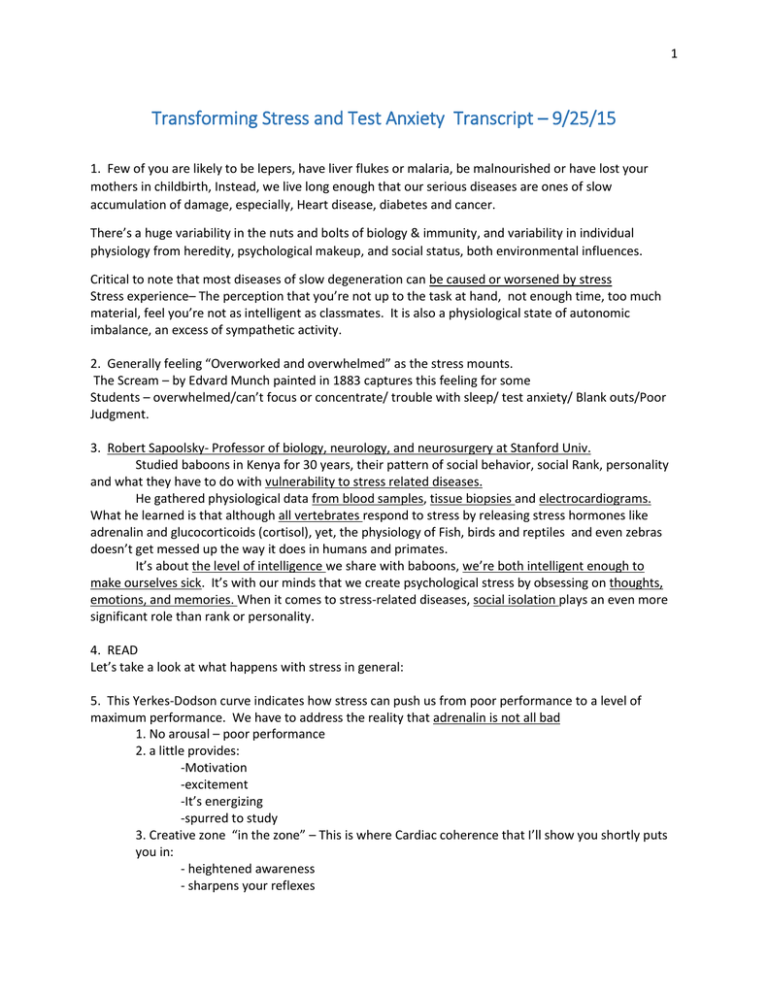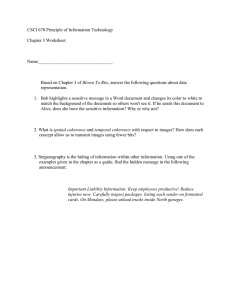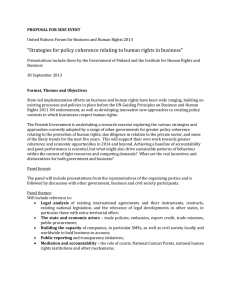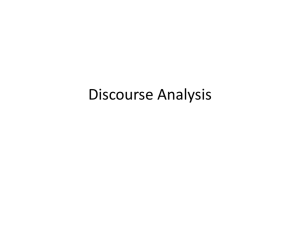Transforming Stress and Test Anxiety Transcript – 9/25/15
advertisement

1 Transforming Stress and Test Anxiety Transcript – 9/25/15 1. Few of you are likely to be lepers, have liver flukes or malaria, be malnourished or have lost your mothers in childbirth, Instead, we live long enough that our serious diseases are ones of slow accumulation of damage, especially, Heart disease, diabetes and cancer. There’s a huge variability in the nuts and bolts of biology & immunity, and variability in individual physiology from heredity, psychological makeup, and social status, both environmental influences. Critical to note that most diseases of slow degeneration can be caused or worsened by stress Stress experience– The perception that you’re not up to the task at hand, not enough time, too much material, feel you’re not as intelligent as classmates. It is also a physiological state of autonomic imbalance, an excess of sympathetic activity. 2. Generally feeling “Overworked and overwhelmed” as the stress mounts. The Scream – by Edvard Munch painted in 1883 captures this feeling for some Students – overwhelmed/can’t focus or concentrate/ trouble with sleep/ test anxiety/ Blank outs/Poor Judgment. 3. Robert Sapoolsky- Professor of biology, neurology, and neurosurgery at Stanford Univ. Studied baboons in Kenya for 30 years, their pattern of social behavior, social Rank, personality and what they have to do with vulnerability to stress related diseases. He gathered physiological data from blood samples, tissue biopsies and electrocardiograms. What he learned is that although all vertebrates respond to stress by releasing stress hormones like adrenalin and glucocorticoids (cortisol), yet, the physiology of Fish, birds and reptiles and even zebras doesn’t get messed up the way it does in humans and primates. It’s about the level of intelligence we share with baboons, we’re both intelligent enough to make ourselves sick. It’s with our minds that we create psychological stress by obsessing on thoughts, emotions, and memories. When it comes to stress-related diseases, social isolation plays an even more significant role than rank or personality. 4. READ Let’s take a look at what happens with stress in general: 5. This Yerkes-Dodson curve indicates how stress can push us from poor performance to a level of maximum performance. We have to address the reality that adrenalin is not all bad 1. No arousal – poor performance 2. a little provides: -Motivation -excitement -It’s energizing -spurred to study 3. Creative zone “in the zone” – This is where Cardiac coherence that I’ll show you shortly puts you in: - heightened awareness - sharpens your reflexes 2 - allows you to perform more quickly -May even help you remember information you may not have remembered otherwise PEAK Performance -then as stress increases performance decreases 4. Fatigue 5. Exhaustion 6. Illness 7. Panic 8. Burnout and Breakdown Trans: while you’re trying to find that “Zone” where everything functions maximally you may find yourself having trouble with… 6. Most often the feeling of stress and overwhelm exhibit as test anxiety. Are you experiencing any of these symptoms? Trans: IF you don’t get a handle on test anxiety, it can morph into… 7. 1. Irritability 2. Diminished sense of humor 3. Worry 4. Excessiveness 5. Forgetfulness 6. Aches and pains 7. Nervousness 8. Fatigue 9. Illness Trans: Lets break this down and look at how stress can affect hour mind, body emotions and behavior: 8. Problem concentrating Short attention span Repetitive or continual thoughts Inability to slow down thought process Confusion Misunderstanding Memory problems Problem making decisions Poor judgment Loss of objectivity Thoughts of running away Trans: this is most of what I see with students – But-Most of the time people that I saw in my practice were referred by their Dr. or the ER staff with physical symptoms with no explanation: 9. Digestive disorders Hair loss Weight gain or loss Skin problems Chest pain Immune system suppression Muscle tension & pain Periodontal disease Headaches Colds and viruses Sweatiness Sleep disturbances 3 Irregular heart beat Fatigue High blood pressure Asthma or shortness of breath Jaw pain Missed periods Trans: And with all of this going on, your emotional state can be pretty uncomfortable 10. Less interest in hobbies or fun Mood shifts Restlessness Frustration Anger resentment Unwarranted jealousy Irritability Oversensitivity Overreactions Overwhelmed Anxiety Fear of failure Inadequacy Depression Apathy Crying Trans: and tis may all result in you doing things you wouldn’t do otherwise: 11. Eat more or less Sleep too much or too little Isolate Avoid work or school Stay late at work or school Increased tobacco, alcohol drugs, caffeine Have sex more or less Nail biting, hair twisting, pacing Teeth grinding Inappropriate laughing or crying Overdo exercise or shopping Bossiness or inflexibility Lose your temper Argumentative Violent Risky behavior Road Rage Trans: Some people never get a handle on how important it is to handle stress well- never understand that it’s a :killer” literally and end up with these conditions: 12. Heart Disease Cancer Diabetes 4 Depression Obesity Substance abuse Anorexia Nervosa Ulcers Irritable bowel syndrome Memory loss Child, elder & sexual abuse.. Trans: None of us want to suffer these long term effects – You’re a long way from having to worry about these conditions but you may end up going through… 13. So – you want to recognize what’s happening before you “Burnout” Here is Joan Boryshenko’s Stages of Descent into Burnout. 14. Read Slide 15. 1.Get enough sleep -Work on study skills at Penn State Univ. reports that sleep is probably the most important and most overlooked aspect of health when trying to stay focused, learn and retain information. 2. Reasons we sleep (1) restores energy in the brain (3% body wt. uses 20-25% of body’s energy (2) Sleep consolidates memory -Sleep is essential for the formation of long term memory -The first memory that is built with a task or new information is susceptible to interference. -After a time memory consolidation sets in, stabilizing the memory. -During sleep consolidation continues, and then leads to the additional benefit of memory enhancement All 4 stages of sleep have been implicated in sleep dependent learning, which means you need the full night to get enough time in all stages. 3. Study on University students, published in Germany June 14. 2014 – “All else equal Students who generally got a good night’s sleep performed better on exams – not relly a surprise -But, the grades of students who slept 7 hours each night during the exam period were nearly 10% higher than those who got less. Trans: And sleep deprivation is itself a stressor… 16. READ – Here are some other things you want to think about… 17. 1.Set your priorities - Principle is that “If we do not set our priorities, circumstances and others will do it for us.” Determine what you want to accomplish 2. Take Personal responsibility - Once you’ve set your priorities you have to take personal responsibility for what you do with your time -Take responsibility by looking at what you’re doing to accomplish your goals -Periodically evaluate what you’re doing -How are you doing? Is it working? Does something need to be changed? 5 Do you need to change your plan from this point on? 18. In order to keep life in balance we have to have Resilience -The innate capacity that life has to overcome difficulties and obstacles -Really, the ability to handle the stresses of life whatever they are 19. This is my list of secrets of resilience, as much from living life, and figuring it out for patients, as studying what others think about resilience 1. Stay Physically fit 2. Attitude of Optimistic Realism -A resolute, unblinking acceptance of reality – “It is what it is” Buddhist Acceptance -Once you do this, you can use your attention and energy to optimize future possibilities 3. Capacity to stay present - Present is all there is, no point in regretting or dwelling on the past, future isn’t here yet, and planning the future happens NOW Meditation is a great way to get better at this 4. - Don’t isolate, healthy relationships are comforting, allowing the parts of our brains responsible for higher functions to continue to develop, i 5. Sense of humor - Gives you a leg up on “reframing”, another way of looking at things, laughing puts your heart in coherence, so your brain is coherent and works better at problem solving 6. Visualize your future - See where you want to be, Dream your dream in full color, feel what it feels like to be there, it helps to get past the tough spots -Some of us don’t come from families who teach us to dream our own dream and hold onto it. 7. Be persistent - Persistent in your efforts, consistent with what works 8. Learn to stay calm - Practice whatever techniques work for you – meditation/yoga/ Quick Coherence techniques for calming anxiety or any other high intensity undesirable emotional state 9. Master your mind - Awareness of negativity- Do your own cognitive therapy and reframe negative thoughts 20. What you can do Attitude – when things go wrong, remind yourself of what’s right – Attitude of gratitude - Attitude of positivity Beliefs – Are there beliefs from your tribe that hold you back? Ex.-No one in my family ever goes to professional school 21. Read Slide 22. I became interested in heart math skills working with several highly distressed clients: -PTSD patients from Desert Storm and Desert Shield with lots of anxiety/ anger problems/- alcohol/ drug problems -Wanted to learn more about the science of self control and self regulation -Began to use it myself for public speaking, disability and custody hearings etc. -Also useful “after” a stressful event to bring cortisol levels down immediately, instead of waiting the usual 8 hours. 6 -There are reasons for putting your heart in a state of coherence that are important and powerful , especially efficient energy utilization -When the heart is in coherence, because there are more neural connection going from the heart to the brain, than the brain to the heart, the brain syncs up to the heart, --When the brain is in coherence, you focus, concentrate, attention, learn, memory and reasoning -Other organ systems also sync up and become more coherent, endocrine system and immune system 23. Volunteer for Cardiac Coherence self regulation technique 24. Quick Coherence Steps: 1. Heart focus – All of your attention on the area of your heart to keep your attention away from the negative chattering of your mind. 2. Heart Breathing – 10 sec. cycle – 5 secs in and 5 secs out 3. Heart feeling – the physical and emotional experience of a positive feeling like gratitude, appreciation, loving kindness etc. 25. Your body spontaneously enters greater coherence naturally with positive emotions Love, joy, caring, appreciation -You may notice yourself smiling as you look at some of these images -It’s the positive emotional state that sets this technique apart from relaxation -Relaxation has more parasympathetic activity instead of a balanced S and P 26. -Normal healthy heart has lots of HRV, heart rate variability -Means heart speeds up and slows down in a regular pattern. S & P alternating -When S & P are perfectly balanced - called Cardiac Coherence (lower pattern) -Here’s where the power of this exercise comes in: When the heart is beating in a coherent pattern, all the other organ systems sync up – the whole body becomes coherent and works in synchrony. Graph on the top shows a heart rhythm typical when stressful negative attitudes and emotions like frustration and anxiety cause chaotic heart rhythms -Part of a physically harmful chain reaction leading to increased cortisol levels,-leading to inhibition of the cortex and an imbalance in ANS. -Graph on the bottom, shows what happens when you shift to a “pos” emotion like appreciation,, love, caring and gratitude, which create smooth coherent heart rhythms -resulting in cortical facilitation or coherence in cortex. 27. Coherence is also used to describe the coupling and degree of synchronization between different oscillating systems. In physiology you get cross coherence when one or more of the body’s oscillatory systems, such as respiration, heart rhythms and blood pressure rhythm become entrained and operate at the same frequency – resulting in less energy utilization, more efficient utilization 28. It’s an important point that the state of coherence is psychologically and physiologically distinct from relaxation. Relaxation – overall reduction in autonomic outflow resulting in lower HRV HRV indicator of resilience, overall health, ability to adapt to stress Graphs on L show typical HRV (ht rhythm patterns) during relaxation and coherence Coherence has greater HRV – indicating greater adaptability to environmental demands 7 Graphs on Right are HRV power spectral density – The relaxation graph shows an increase in the parasympathetic activity, low energy state resting body and mind, but the coherence graph shows calm balanced energized responsive state conducive to mental acuity, focus, problem solving, decision making & physical activity and coordination. Trans: Here’s what happens between the heart and the brain 29. The Heart–Brain Connection Stressed – adrenals produce cortisol which act on the emotional center of the brain, the amygdala, the Fight or Flight center which inhibits cognitive function. -Stress also causes disordered HRV rhythm, more S stimulation causing an imbalance in the system - It’s not as commonly known that the heart actually sends more signals to the brain than the brain sends to the heart! -When you have a positive emotional state it affects the HRV and causes it to be ordered, stable and coherent, and facilitates Cognitive function. Trans: Next we’ll look at what goes on within the brain 30. When one of your senses picks up something threatening, an alarm rings in the amygdala, a primitive part of the brain, part of the limbic system that has to do with fight or flight., survival Here’s what happens - You see in an email or in the syllabus that there’s an exam on a given date-if you tend to have test anxiety, you might as well have seen a brown bear approaching your path in the woods, the brain doesn’t know the difference The amygdala, sounds the alarm, SNS send message to the hypothalamus (the communication center) to do something, like get us ready to run, which tells the adrenals to get us out of here! The adrenals release adrenaline, and then cortisol, cortisol keeps the alarm bell ringing. When that keeps happening, you’re supposed to be running or fighting, not studying, so your cortex, (which isn’t involved in this process at all right now is essentially off line. Dr. Daniel Amen, a clinical neuroscientist, child and adolescent psychiatrist has been doing brain research for 10 years, first EEGs then SPECT scans. -He’s challenging the current paradigm in psychiatry by looking at the scans, the physical evidence for what has been considered a psychological problem. In the mPFC you get the opposite situation This area is responsible for all higher functions, what we call executive functions including working memory and strategic attention. -When the Amygdala is overactive the mpfc (medial prefrontal cortex) shuts down. But, the end result for you, when you have high activity in these areas, you don’t think as well. Trans: And that’s not the only reason why your emotional state will override your ability to think. 31. Cognitive and emotional are separate but interacting functions -They communicate via bi-lateral neural connections between the cortex and the emotional centers of the amygdale –Fight or flight This is the physiological basis of the common experience that emotions like anxiety can dominate the mental landscape : The neural connections from the emotional centers to the cognitive are stronger and more numerous than the other way around. They also operate at a higher speed, so that emotions can bypass the reasoning process entirely, “emotional high-jacking” 8 -So, despite what you know intellectually (“I know I knew this material for the test”) your anxiety disrupts your ability to; -pay attention -have clear perception -use your memory -reason logically - make rational decisions 32. EVOLUTIOANARY BASIS Amygdala, which is the core of the neural circuitry for fear and anxiety- evolved before the neo-cortex but it’s still there working to help us survive danger – Highly attuned to danger – Hyper-reactive to perceived threat – “Fight or flight” – Unfortunately these primitive fear circuits can’t tell the difference between real and imagined danger, between a mugger lurking in the dark and a test lurking next week. Transition – Why is that? 33. -Amygdala is also not just central to fear but to the memory of fear. The wiring in the amygdala established by stressful situations remains unchanged, it’s supposed to remember these threats and generalize fearful experiences to as many situations as possible, helping us to survive -Compare this to the Hippocampus responsible for much of the memory you need for learning. It’s like an “Etch A Sketch, “ready to be turned over, shaken and influenced by experience after experience – constantly remodeled in response to new details, -Amygdala is not remodeled except by specialized types of psychotherapy Trans: So, how does that relate to stress and the remodeling of our brain? 34. Here’s what we know about stress and your brain over the long term: Rockefeller University Science for the Benefit of Humanity Site: “Chronic stress affects attention by altering neuronal growth in the brain” -Life experiences actually appear to change the length and complexity of individual brain cells (neuroplasticity) which can be both beneficial or detrimental Studies with rats showed that stressed rats had neurons in this area responsible for attention that were shorter and had less branching -Stress produced almost as large a deficit in tasks requiring attention and attention shifting, as rats that had brain lesions. *More stress and anxiety, the stronger the pathways to produce it! Trans: Let’s look at what impairs HRV besides stress - and consequently your ability to focus, concentrate and learn, and what improves coherence and the ability to focus, concentrate, learn and recall 35. What reduces cardiac coherence: Age – 3% /year Tobacco Pollution Myocardial infarction 9 Work related fatigue Anger/Sadness/Worry/Anxiety/Panic disorder Separation from loved ones/isolation PTSD Trans – So by what we do every day we improve coherence or not – And you want to have a balanced system36. Positive emotions – love, joy, compassion, care, enthusiasm ( many within “relationship”) Light Sleep Exercise 37. Vacations Omega 3 FA Meditation/Yoga Sex 38. EmWave 2- Biofeedback devise that is a coherence trainer 39






